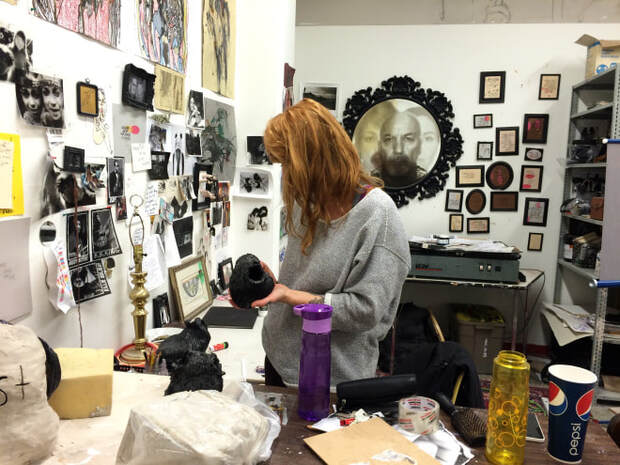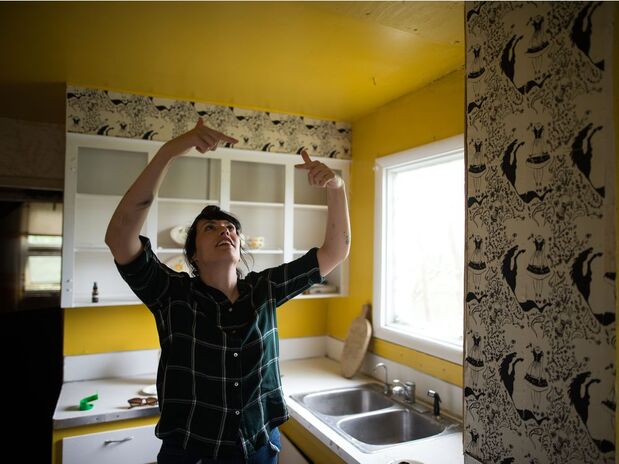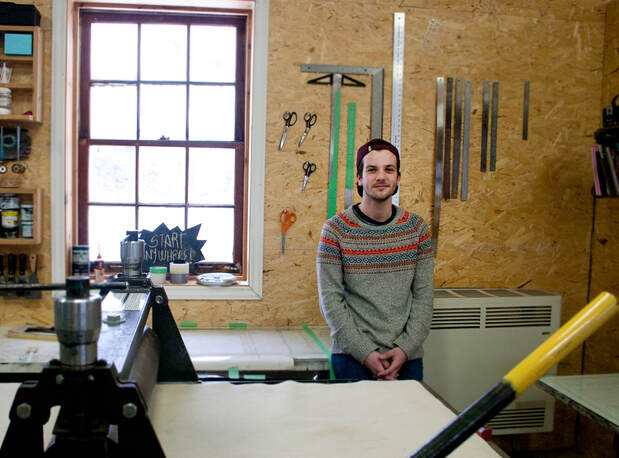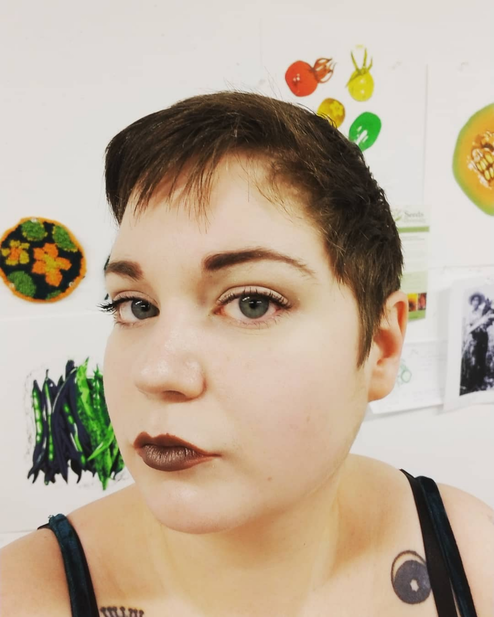Graduate Supervision
According to records of the Department of Visual Art, there had been no graduate students in Printmaking for several years, leading up to my appointment in 2007. At present, I am supervising two students pursuing graduate work, and co-supervising a third. I have successfully supervised or co-supervised 10 MFAs to completion, prior.
I believe that my re-invigoration of the Printmaking area at the University of Regina, as well as my profile, and approach have aided in the ability of the institution to recruit and retain graduate students. Graduate teaching is very different than undergraduate teaching, as any seasoned instructor will point out. I have learned a great deal through exposure to my colleagues in the Department of Visual Art, particularly Professor Leesa Streifler, whose mentorship in co-supervising my first graduate student, was absolutely invaluable.
I believe that my re-invigoration of the Printmaking area at the University of Regina, as well as my profile, and approach have aided in the ability of the institution to recruit and retain graduate students. Graduate teaching is very different than undergraduate teaching, as any seasoned instructor will point out. I have learned a great deal through exposure to my colleagues in the Department of Visual Art, particularly Professor Leesa Streifler, whose mentorship in co-supervising my first graduate student, was absolutely invaluable.
 Exhibition poster for "Here There Be Monsters". Courtesy A. Damsma.
Exhibition poster for "Here There Be Monsters". Courtesy A. Damsma.
Amanda Damsa
Co-supervised with Professor Leesa Streifler
MFA Visual Arts programme entry 2009
Successfully defended 2011
External Examiner: Mark Bovey, NSCAD
Here, There Be Monsters
Here, There Be Monsters playfully illustrates the personal memories and realities of growing up between homes, as the child of divorced parents. The surreal drawings of suitcases — which appear to be part creature and part machine — are a metaphor for the mobile lifestyle that was a result of moving between the discreet households of my separated parents and two sets of grandparents.
While these are nonsensical renderings of luggage bags, by adding teeth, claws, wheels and gears they have the imagined potential to take on a life of their own. The life that I imagine for them is one that facilitates mobility. Humorously fulfilling my desire to adapt to a transient way of life the bags suggest that they can pack themselves and move on their own. The suitcases are childlike inventions that express naïve understandings of how things work as well as the anxieties and confusion that comes with living between places.
The routine of packing and unpacking is both a physical and mental endeavor. It is an act of mental preparation, an attempt at relocating oneself to a new location. The gears that appear throughout the exhibition are metaphors for the psychological switching of gears that is the result of transitioning from one place to another. The work considers the effect of relocation in respect to notions of the home and to what degree it is possible to feel at home in multiple places.
The work is created through screen printing and incorporates the specific colours and patterns from my remembered experiences. I use screen print as a way to celebrate the history of prints as visual communication and conveyers of information. There is a long-standing tradition of capturing and communicating tales of travel through printed material. Maps and books act as reminders of the places we have been, the places we will go to, and fantastical places we escape to in our mind.
The exhibition is a space to play, laugh and share. Please be warned that —like the mysterious beast and serpents created by early mapmakers— many creatures are waiting to be unpacked and discovered within the gallery... Here, There Be Monsters.
- Amanda Damsma, 2011
 Still from Cynefin, courtesy R. Pantel.
Still from Cynefin, courtesy R. Pantel.
Rowan Pantel
MFA Visual Arts programme entry 2011
Successfully defended 2013
External Examiner: Joan Borsa
Cynefin
The exhibition explores themes of childhood memories, family folklore and the impossibility of repeating any single moment in time. I am exploring these ideas while utilizing images of the forest I grew up next to, and merging memories with dreams and fairytales. The forest represents the memories that are always persistent but are constantly changing and shifting under my feet, despite my best effort to record the ‘truth’.
There have been many threads that have come out of my research and investigation into memory and folklore. Gaston Bachelard’s Poetics of Space was a key resource, which led me to further explore the theatrical use of space within the gallery setting. The work crosses boundaries between reality and folklore, and explores our childhood perceptions and memories. - R. Pantel, 2013
MFA Visual Arts programme entry 2011
Successfully defended 2013
External Examiner: Joan Borsa
Cynefin
The exhibition explores themes of childhood memories, family folklore and the impossibility of repeating any single moment in time. I am exploring these ideas while utilizing images of the forest I grew up next to, and merging memories with dreams and fairytales. The forest represents the memories that are always persistent but are constantly changing and shifting under my feet, despite my best effort to record the ‘truth’.
There have been many threads that have come out of my research and investigation into memory and folklore. Gaston Bachelard’s Poetics of Space was a key resource, which led me to further explore the theatrical use of space within the gallery setting. The work crosses boundaries between reality and folklore, and explores our childhood perceptions and memories. - R. Pantel, 2013
 Exhibition poster for "Antisocial Media". Courtesy G. Lague.
Exhibition poster for "Antisocial Media". Courtesy G. Lague.
Geremy Lague
Co-supervised with Professor Gerald Saul
Interdisc MFA programme entry 2012
Successfully defended 2015
External Examiner: Lauren Nurse
Lague Corp. Presents Antisocial Media
Through my exhibition, I aim to offer a critique of current social media practice, by creating an alternative experience through a fictional corporation called LAGUE CORP. and the artwork created under its banner. The founder of LAGUE CORP., named Mr. Lague, is a caricaturized version of myself that enables me to form this critique. Through Mr. Lague I am able to simultaneously express the disconnect I perceive in the use of social media, and create something that re-establishes this connection.
The works presented in the exhibition cover a wide range of technical and conceptual practices. These include: performance, letterpress printing, lenticular imagery, photo printing, hand operated animation devices such as the mutoscope and flipbook, traditional dark room processes in the formation of View-Master imagery, sound, 16mm film, and stereoscopic 3D techniques.
The conceptual basis for the exhibition lies in my understanding of how social media operates within society through the theories of Allan Sekula, Louis Althusser, and Michel Foucault. This is juxtaposed with the methodology of media archeology and the theories of Siegfried Zielinski, Jussi Parikka, Erkki Huhtamo, and Wolfgang Ernst.
- G. Lague, 2014
Co-supervised with Professor Gerald Saul
Interdisc MFA programme entry 2012
Successfully defended 2015
External Examiner: Lauren Nurse
Lague Corp. Presents Antisocial Media
Through my exhibition, I aim to offer a critique of current social media practice, by creating an alternative experience through a fictional corporation called LAGUE CORP. and the artwork created under its banner. The founder of LAGUE CORP., named Mr. Lague, is a caricaturized version of myself that enables me to form this critique. Through Mr. Lague I am able to simultaneously express the disconnect I perceive in the use of social media, and create something that re-establishes this connection.
The works presented in the exhibition cover a wide range of technical and conceptual practices. These include: performance, letterpress printing, lenticular imagery, photo printing, hand operated animation devices such as the mutoscope and flipbook, traditional dark room processes in the formation of View-Master imagery, sound, 16mm film, and stereoscopic 3D techniques.
The conceptual basis for the exhibition lies in my understanding of how social media operates within society through the theories of Allan Sekula, Louis Althusser, and Michel Foucault. This is juxtaposed with the methodology of media archeology and the theories of Siegfried Zielinski, Jussi Parikka, Erkki Huhtamo, and Wolfgang Ernst.
- G. Lague, 2014
 Lacia at David Krut Studio, South Africa.
Courtesy David Krut.
Lacia at David Krut Studio, South Africa.
Courtesy David Krut.
Lacia Vogel
MFA Visual Arts programme entry 2013
Successfully defended 2015
External Examiner: April Dean
Repeat
The Exhibition Repeat is an aesthetically spare installation consisting of carefully and precisely fashioned prints and predominantly blank sculptural paper forms. Through the artworks presented in the R.H.W. Foundation Gallery at the MacKenzie Art Gallery, I am trying to visualize how matter coalesced into individual forms at the beginning of time, and how human life evolved from that primordial space and time. A number of the pieces are books, or book-like objects. Ironically through a lack of text, the blankness in these sculptures implicitly poses a number of questions about words, such as: Where did language come from? How did we learn to communicate? What is our relationship to language? The prints that line the gallery walls use circles to symbolize the first stars and planets that appear in this imagined universe.
This exhibition embodies the results of my research into the value of manual and meditative artistic methods. The use of unembellished paper as both medium and subject symbolizes, at the least, my desire to elevate the supporting material to the same level as the subject matter typically imposed upon it. This supporting document gives a comprehensive account of the artistic work leading up to the exhibition Repeat and explains the conceptual and theoretical underpinnings of the show.
By cutting and folding large amounts of paper by hand for many hours on end, I have developed a deeper understanding of what motivates me as an artist. Particular methods generate a sense of equilibrium in a world whose pace sometimes threatens to overwhelm my senses. My practice has been enriched by reflections on the literal idea of nothing, philosophical concepts of Nothingness and repetition, and the earnest but unattainable human desire to achieve perfection. My personal quest for exactitude resulted in an exhibition in which the forms demonstrate a high regard for meticulous and attentive effort.
- L.Vogel, 2015
MFA Visual Arts programme entry 2013
Successfully defended 2015
External Examiner: April Dean
Repeat
The Exhibition Repeat is an aesthetically spare installation consisting of carefully and precisely fashioned prints and predominantly blank sculptural paper forms. Through the artworks presented in the R.H.W. Foundation Gallery at the MacKenzie Art Gallery, I am trying to visualize how matter coalesced into individual forms at the beginning of time, and how human life evolved from that primordial space and time. A number of the pieces are books, or book-like objects. Ironically through a lack of text, the blankness in these sculptures implicitly poses a number of questions about words, such as: Where did language come from? How did we learn to communicate? What is our relationship to language? The prints that line the gallery walls use circles to symbolize the first stars and planets that appear in this imagined universe.
This exhibition embodies the results of my research into the value of manual and meditative artistic methods. The use of unembellished paper as both medium and subject symbolizes, at the least, my desire to elevate the supporting material to the same level as the subject matter typically imposed upon it. This supporting document gives a comprehensive account of the artistic work leading up to the exhibition Repeat and explains the conceptual and theoretical underpinnings of the show.
By cutting and folding large amounts of paper by hand for many hours on end, I have developed a deeper understanding of what motivates me as an artist. Particular methods generate a sense of equilibrium in a world whose pace sometimes threatens to overwhelm my senses. My practice has been enriched by reflections on the literal idea of nothing, philosophical concepts of Nothingness and repetition, and the earnest but unattainable human desire to achieve perfection. My personal quest for exactitude resulted in an exhibition in which the forms demonstrate a high regard for meticulous and attentive effort.
- L.Vogel, 2015
 Kallie in the studio, University of Regina. Courtesy K. Garcia.
Kallie in the studio, University of Regina. Courtesy K. Garcia.
Kallie Garcia
Co-supervised with Professor Sean Whalley
MFA Visual Arts programme entry 2015
Successfully defended 2017
External Examiner: Kim Hyuhn, U of C
Altogether but Unsettling
The Exhibition is a comprehensive view of my studio practice and includes two dimensional multimedia paintings, drawings, Silkscreen prints and photographs, as well as film projections and sculptures all inspired by personal struggles that confess secrets of vulnerability.
The exhibition explores memories and experiences using child’s play motifs, the notion of home, hair, nests and fort like structures to create personal narratives. Within these narratives I invite the viewer to relate to and
witness the value of confiding in one another and allowing for personal vulnerability.
Many of my thoughts have developed from journaling while investigating personal memories and vulnerabilities. Brene Brown’s Daring Greatly, How the Courage to Be Vulnerable Transforms the Way We Live, Love, Parent and Lead was an inspiring resource which led me to further explore confessing personal vulnerabilities through art making, creating a space within the gallery to allow the viewer to bear witness.
- K. Garcia, 2017
Co-supervised with Professor Sean Whalley
MFA Visual Arts programme entry 2015
Successfully defended 2017
External Examiner: Kim Hyuhn, U of C
Altogether but Unsettling
The Exhibition is a comprehensive view of my studio practice and includes two dimensional multimedia paintings, drawings, Silkscreen prints and photographs, as well as film projections and sculptures all inspired by personal struggles that confess secrets of vulnerability.
The exhibition explores memories and experiences using child’s play motifs, the notion of home, hair, nests and fort like structures to create personal narratives. Within these narratives I invite the viewer to relate to and
witness the value of confiding in one another and allowing for personal vulnerability.
Many of my thoughts have developed from journaling while investigating personal memories and vulnerabilities. Brene Brown’s Daring Greatly, How the Courage to Be Vulnerable Transforms the Way We Live, Love, Parent and Lead was an inspiring resource which led me to further explore confessing personal vulnerabilities through art making, creating a space within the gallery to allow the viewer to bear witness.
- K. Garcia, 2017
 Jessica installing the "Haus Project", Nokomis 2019. Courtesy J. Richter.
Jessica installing the "Haus Project", Nokomis 2019. Courtesy J. Richter.
Jessica Richter
MFA Visual Arts programme entry 2014
Successfully defended 2017
External Examiner: Heather Huston, AUofA
Hausmärchen
This exhibition and paper explores the complex relationship I had with my grandma, Adelheid Richter, through the context of her experiences as a German citizen during World War II and her experiences as an immigrant to Canada following the war. The exhibition contains four multimedia, sculptural pieces, evoking the landscape and houses of my grandparent’s farm and the Black Forest Weather Houses that they kept on their knick-knack shelves.
This support paper discusses the history as well as family lore that has contributed to the work. I give a description of the exhibition, and then delve into the military and social history of World War II Germany, to provide context for my grandma’s early experiences both pre, and post, emmigration. First, I discuss the political and social climate of East Prussia at the close of the war; where my grandma was situated as a female civilian. Following this, I explore and explain the culture and challenges experienced by German immigrants to Canada in the aftermath of the war, contextualizing my grandma’s assimilation to Canada and the consequences this had on subsequent generations. Once I have established the historical and social context, I discuss how the trauma of war contributed to the fractured relationships within my family, and the notion of “decay” as a means to express that. The use of the miniature is discussed, leading into the aesthetic inspirations of the work. I discuss my work in the context of female folk art, contrasting the tradition of papercutting and my laser cutting. Additionally, I delve into the role of Twee culture, feminine aesthetics, and Grimm’s Fairy Tales as both aesthetic and conceptual inspirations. Finally, I conclude with a discussion of artists Amalie Atkins and Heather Benning, and their influence on the process of the work.
- J. Richter, 2017
MFA Visual Arts programme entry 2014
Successfully defended 2017
External Examiner: Heather Huston, AUofA
Hausmärchen
This exhibition and paper explores the complex relationship I had with my grandma, Adelheid Richter, through the context of her experiences as a German citizen during World War II and her experiences as an immigrant to Canada following the war. The exhibition contains four multimedia, sculptural pieces, evoking the landscape and houses of my grandparent’s farm and the Black Forest Weather Houses that they kept on their knick-knack shelves.
This support paper discusses the history as well as family lore that has contributed to the work. I give a description of the exhibition, and then delve into the military and social history of World War II Germany, to provide context for my grandma’s early experiences both pre, and post, emmigration. First, I discuss the political and social climate of East Prussia at the close of the war; where my grandma was situated as a female civilian. Following this, I explore and explain the culture and challenges experienced by German immigrants to Canada in the aftermath of the war, contextualizing my grandma’s assimilation to Canada and the consequences this had on subsequent generations. Once I have established the historical and social context, I discuss how the trauma of war contributed to the fractured relationships within my family, and the notion of “decay” as a means to express that. The use of the miniature is discussed, leading into the aesthetic inspirations of the work. I discuss my work in the context of female folk art, contrasting the tradition of papercutting and my laser cutting. Additionally, I delve into the role of Twee culture, feminine aesthetics, and Grimm’s Fairy Tales as both aesthetic and conceptual inspirations. Finally, I conclude with a discussion of artists Amalie Atkins and Heather Benning, and their influence on the process of the work.
- J. Richter, 2017
 Brian at Sparkbox Studio, Artist-in-Residence. Courtesy Sparkbox.
Brian at Sparkbox Studio, Artist-in-Residence. Courtesy Sparkbox.
Brian Hoad
MFA Visual Arts programme entry 2015
Successfully defended 2017
External Examiner: Sean Caulfield, U of A
Handrails
The exhibition is a reflection surrounding the artist, myself, attending and working at a summer camp from 2001-2013.
Handrails are recognizable symbols included on maps to assist in navigation. These include fences, roads, key buildings, etc. At Quin-Mo-Lac a glacial erratic served as the most notable one of these on the ecological hiking trail. Glacial erratics are rocks that were formed elsewhere and are now set in areas not native to them. Despite appearing as a permanent fixture within the landscape, they have physical properties to indicate their foreign origins. In this exhibition, the metaphor of handrail and glacial erratic have been explored in a manner connecting experiences with camp and wilderness to a critical evaluation of how wilderness institutions carry out ideological agendas.
The first section of this paper will outline my interest in aligning Michel Foucault’s conceptual heterotopia with the North American summer camp (specifically Camp Quin-Mo- Lac) while also identifying the ways in which my experiences attending and working at camp situate themselves with my coming-of-age experience, ultimately arriving at an affective, sentimental experience within nature. This is in alignment with the philosophy that Simone Weil directs towards nationhood, specifically, her text The Need For Roots; Prelude to a Declaration of Duties Towards Mankind. Following these theoretic discussions, artistic influences will be acknowledged as I situate my own work alongside theirs. The practice-based research methodologies used and creative processes will then be reviewed, prior to describing the exhibition in detail.
- B. Hoad, 2017
MFA Visual Arts programme entry 2015
Successfully defended 2017
External Examiner: Sean Caulfield, U of A
Handrails
The exhibition is a reflection surrounding the artist, myself, attending and working at a summer camp from 2001-2013.
Handrails are recognizable symbols included on maps to assist in navigation. These include fences, roads, key buildings, etc. At Quin-Mo-Lac a glacial erratic served as the most notable one of these on the ecological hiking trail. Glacial erratics are rocks that were formed elsewhere and are now set in areas not native to them. Despite appearing as a permanent fixture within the landscape, they have physical properties to indicate their foreign origins. In this exhibition, the metaphor of handrail and glacial erratic have been explored in a manner connecting experiences with camp and wilderness to a critical evaluation of how wilderness institutions carry out ideological agendas.
The first section of this paper will outline my interest in aligning Michel Foucault’s conceptual heterotopia with the North American summer camp (specifically Camp Quin-Mo- Lac) while also identifying the ways in which my experiences attending and working at camp situate themselves with my coming-of-age experience, ultimately arriving at an affective, sentimental experience within nature. This is in alignment with the philosophy that Simone Weil directs towards nationhood, specifically, her text The Need For Roots; Prelude to a Declaration of Duties Towards Mankind. Following these theoretic discussions, artistic influences will be acknowledged as I situate my own work alongside theirs. The practice-based research methodologies used and creative processes will then be reviewed, prior to describing the exhibition in detail.
- B. Hoad, 2017
 From the "Cabela Boys" series. Courtesy T. D-Evancio.
From the "Cabela Boys" series. Courtesy T. D-Evancio.
Tye Dandridge-Evancio
MFA Visual Arts programme entry 2017
Sucessfully defended 2020
External Examiner: Marcus Miller
Cabela Boys
MFA Visual Arts programme entry 2017
Sucessfully defended 2020
External Examiner: Marcus Miller
Cabela Boys
 Madeleine in the studio, University of Regina. Courtesy M. Greenway.
Madeleine in the studio, University of Regina. Courtesy M. Greenway.
Madeleine Greenway
MFA Visual Arts programme entry 2018
Successfully defended Summer 2021
External Examiner: Lauren Fournier
MFA Visual Arts programme entry 2018
Successfully defended Summer 2021
External Examiner: Lauren Fournier
 Photo courtesy of Alyssa Scott
Photo courtesy of Alyssa Scott
Alyssa Scott
MFA Visual Arts programme entry 2020
Successfully defended Fall 2022
External Examiner: Jonathan S. Green
MFA Visual Arts programme entry 2020
Successfully defended Fall 2022
External Examiner: Jonathan S. Green
 Nicole doing a demo in ART270.
Nicole doing a demo in ART270.
Nicole Banton
MFA Visual Arts programme entry Fall 2022
MFA Visual Arts programme entry Fall 2022

Rozhin Tayarani
Co-supervised with Professor Holly Fay
MFA Visual Arts programme entry Fall 2022
Co-supervised with Professor Holly Fay
MFA Visual Arts programme entry Fall 2022

